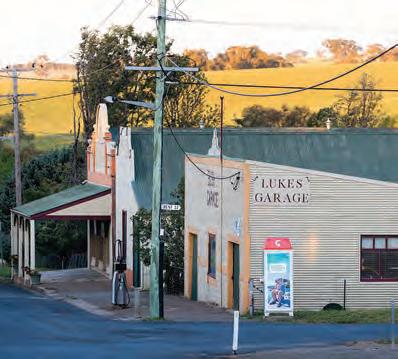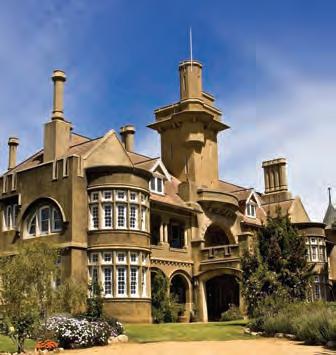
7 minute read
Villages
Rich in history, the origins of our villages come from mining, European settlement, agriculture, post World War I soldier settlement and the development and maintenance of rail networks. The varying styles of architecture provide clues to the timeline of when each village was established.
Monteagle
Enveloped in orchards and olive groves, the village of Monteagle is 15 minutes north of Young. Touts Lookout is a 15 minute drive from Monteagle along the gravel Scenic Road. Offering stunning panoramic views of the district, it is also a perfect spot for kite flying. Iandra Castle, a 20 minute drive from Monteagle, is open periodically throughout the year. The property was originally purchased in 1878 and over time the homestead has been converted and restored a number of times and is listed on the NSW Heritage Database. Set on a working farm dating back to the 1850s, the Rustic Maze and Country Garden is like stepping back in time. Wander through the beautifully maintained garden and enjoy a coffee at The Old Shearers Quarters Café. Open by appointment only for tour groups of 12 or more people, please ensure you call ahead of visiting.
Photo credit: John Mewett
Koorawatha
Derived from the Wiradjuri language meaning ‘pine trees’, Koorawatha is a 30 minute drive from Young and 20 minutes from Murringo. Once a prosperous railway junction, the village now moves at a calmer pace. Originally established in 1884, Hotel Koorawatha serves delicious country pub meals and local wines. Enjoy ice cold beer in the beer garden and stay the night in one of six comfy hotel rooms. A cairn marks the former site of the old Bang Bang Hotel where in 1864, infamous bushranger Ben Hall and his gang engaged in a gun battle with police after trying to steal racehorses. Visit the Koorawatha Nature Reserve for bush walking and bird watching; birds to be spotted include the chestnut-rumped heathwren and brown-headed honeyeater. Travel through Murringo gap on the 20 minute drive from Koorawatha to Murringo and stop at the small picnic area located next to the Murringo Creek; an ideal place to enjoy lunch and watch the local wildlife.
BELOW LEFT: Iandra Castle, nearby in the Weddin Shire
BELOW: Hotel Koorawatha
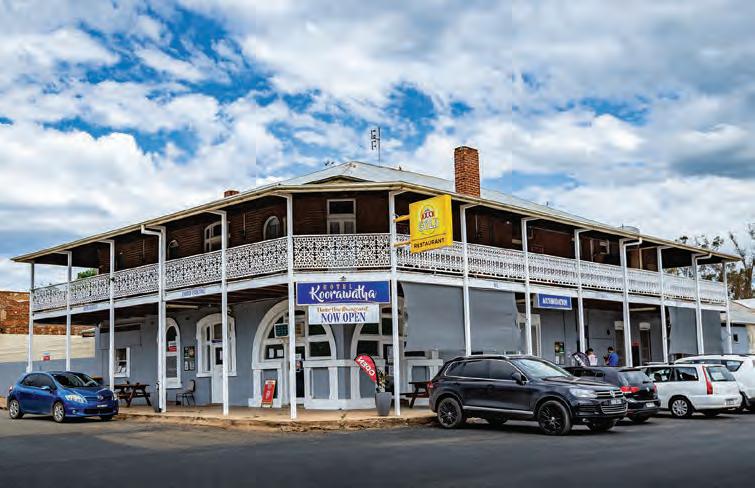
Wirrimah
The quaint village of Wirrimah is surrounded by plum and olive orchards. Remains of the prune dehydrator, now a private residence, reminds visitors of Wirrimah’s soldier settler history. As you drive along the Scenic Road from Bendick Murrell or from Koorawatha or Monteagle soak in the stunning landscape and spot kangaroos and sheep.
Maimuru
The picturesque village of Maimuru sits on a rise 15 minutes north-west of Young and offers amazing views of the surrounding broad acres and orchards. Settled by soldiers post World War I, its once intensive prune production has given way to olive production. In April 2021, Maimuru Public School housed in a charming wooden building, celebrated their 100 year anniversary.
Bendick Murrell
The village of Bendick Murrell, named after the pastoral station on which it was built, is located on the Olympic Highway 20 minutes north-east of Young. Once a railway maintenance settlement, Bendick Murrell is now the region’s equestrian centre and is recognised for its regular events and first-rate recreation ground.
Bribbaree
Bribbaree is situated on the northwest edge of the Hilltops Region and just 35 minutes from Young. Visit the monument commemorating five soldiers from Bribbaree who died in World War I. The Rusty Horse Hotel is the heart of this small village and an excellent base for exploring the nearby Weddin Mountains National Park and Ben Hall’s Cave to the east. The annual show, held on the Saturday of the October long weekend, provides a showcase for local talent and produce.
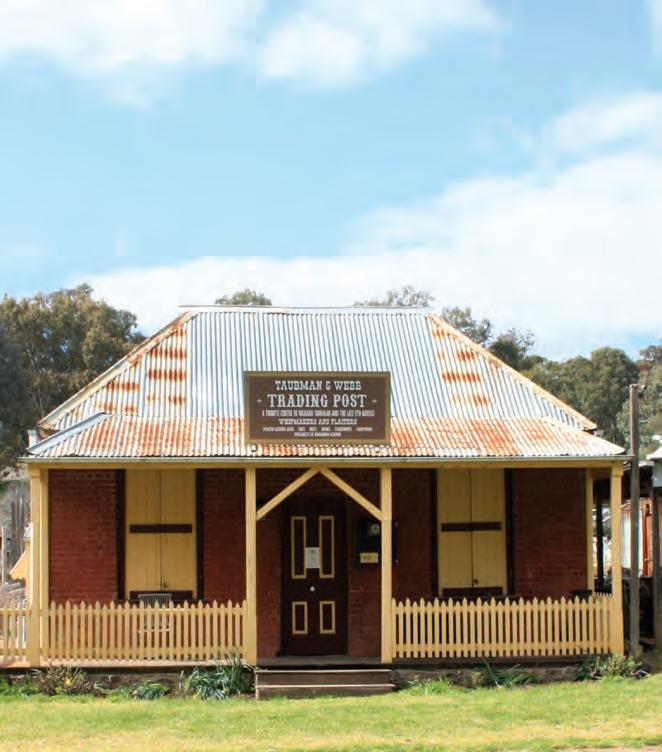
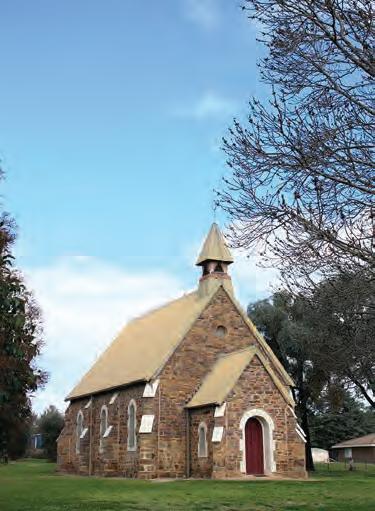
ABOVE: Murringo Village Church
Murringo
Murringo Village, located approximately 20 minutes from Young and Boorowa, is the oldest village in the region. A site where gold miners once dug, the village boasts fine stone buildings, including two churches, a cemetery where you can read numerous stories from headstones, Georgian cottages and the schoolhouse built in 1862 that is still educating our children today. A visit to the Taubman and Webb Trading Post to learn the history of the late Syd Bayliss; renowned bushman, plaiter and whip maker is a must. While here, view leather items made and used by Syd and attend a whip making class and demonstration by Richard Taubman; the attraction’s name-sake who along with his wife Leah, are dedicated to keeping the Trading Post open. The Trading Post also stocks local Hilltops Honey, and Trandari Wines, both high-quality specialist producers from the Hilltops Region.
LEFT: Taubman and Webb Trading Post
Reids Flat
The village of Reids Flat is located on the south bank of the Lachlan River, one hour drive north-east of Boorowa. Hidden in the Great Dividing Range, there is a rich indigenous dreaming associated with the valley. Bushrangers were active in the area during the early 1860s; caves within the surrounding rocky mountains provided excellent hiding spots. Local merino sheep wool production is amongst the finest in the world. The village does not have any commercial establishments and the closest shop is 22 kilometres away so bring a picnic.
Rugby
Located 25 minutes north-east of Boorowa, Rugby is the eastern most village in the Hilltops Region. Established when the Walla Walla silver mine was in operation, first settlers to the area cleared dense thick scrub to build their homes. The ruins of the mining village and old mine-heads serve as lasting reminders of the origins of the town and the mine that was abandoned in 1919. The Rugby Community Hall boasts beautiful brickwork and the early church buildings contribute to the charming streetscape of this village.
Rye Park
European settlers arrived to farm the land of Rye Park in the 1840s. A 15 minute drive south-east of Boorowa, Rye Park was once the site of one of the richest silver mines in NSW. The landscape has also seen periods of mining for tin, but today, the area is known for the production of wool and meat. The school opened in 1876 and the local post office operates from the Uniting Church Hall for one hour a day, four days a week. Hamilton Hume’s family settled in the area in 1865, their homestead now a privately owned working sheep property. The pristine waterways of Pudman Creek run beside the village. Find a place to stop, enjoy a picnic and soak in the serenity.
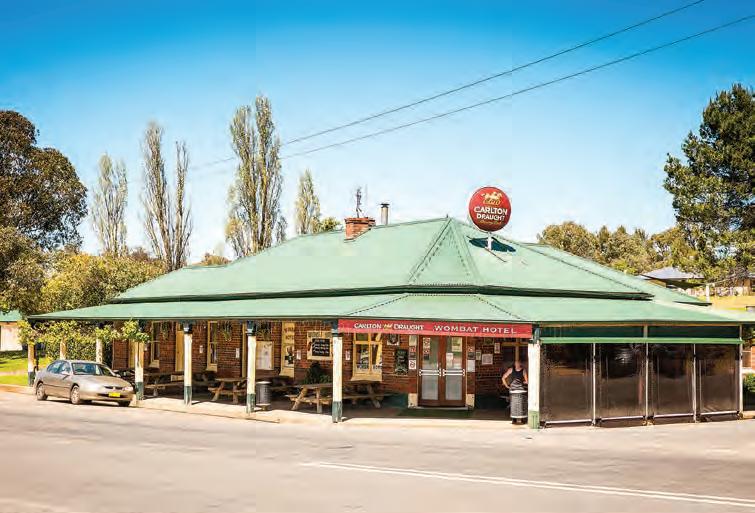
ABOVE: Wombat Hotel
Frogmore
Copper was first discovered and mined in the village of Frogmore in the 1850s. A 20 minute drive northeast of Boorowa, the area also bore other metals; silver and tungsten. Striking Granite Tors can be seen in the area around the village. Wyangala Dam is a 30 minute drive north-east. The lake is a popular sport and recreation destination.
Kingsvale
North-east of Wombat, and a 10 minute drive from Young, is the village of Kingsvale. Once known as one of the major centres of Hilltops stone fruit industry, Kingsvale boasts several large orchards where you can pick-your-own box of fruit to take home. As you travel the picturesque roads, stop and enjoy a roadside picnic and take in the stunning scenery.
Wombat
The village of Wombat is just a 15 minute drive from Young. Following the discovery of gold in the 1860s, Wombat was established in 1865 when Chinese miners moved to the area. Home to a population of 225 (according to the last census), Wombat offers antiques and bric-abrac, fresh farmgate produce, and Wombat Cellars stocking locally made liqueurs and Hilltops wines. The local pub, the Wombat Hotel, has been trading continuously since 1877 and hosts live bands throughout the year.
Galong
Established in the late 1820s when squatter and former Irish convict Edward ‘Ned’ Ryan built Galong House, the village of Galong is 30 minutes south-west of Boorowa, and 20 minutes from Harden. The town’s limestone open-cut mine has been the major industry since 1885 and today, produces about one quarter of New South Wales’ requirement of agricultural lime. The walled cemetery, with heritage significance, contains graves dating back to 1854 and Galong Railway Station, originally opened in 1877, is now closed and heritage-listed.
St Clement’s Retreat & Conference
Centre is an historic monastery set on more than 300 hectares of rural land and ideal for conferences, workshops, seminars and religious retreats.
BELOW: Village of Galong
